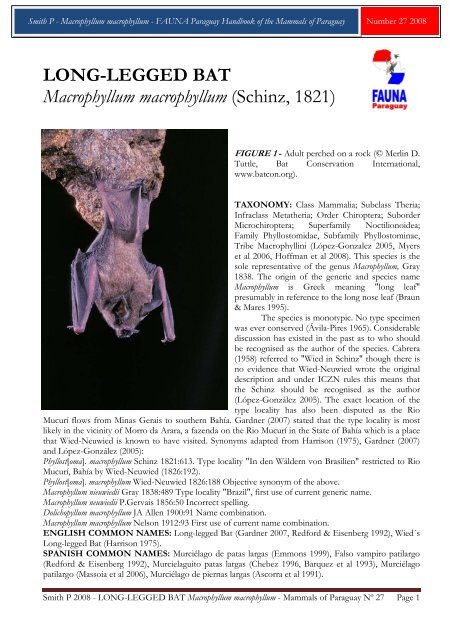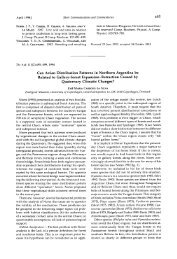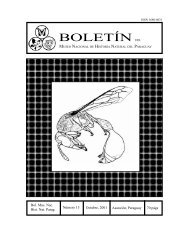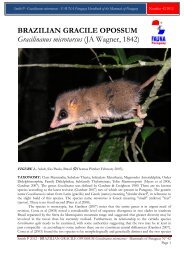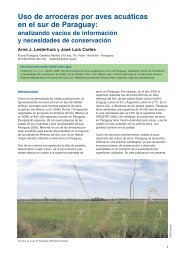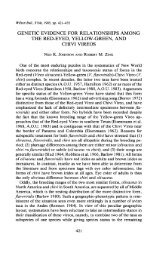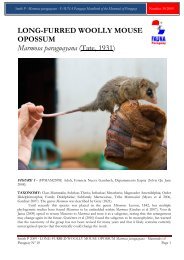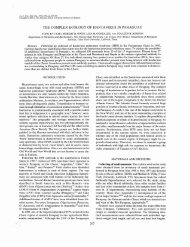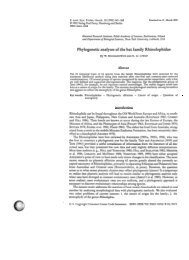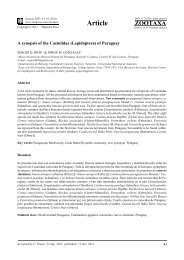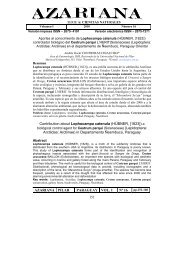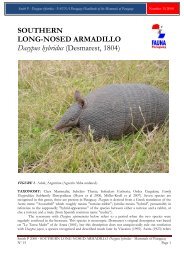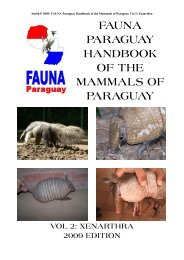LONG-LEGGED BAT Macrophyllum ... - FAUNA Paraguay
LONG-LEGGED BAT Macrophyllum ... - FAUNA Paraguay
LONG-LEGGED BAT Macrophyllum ... - FAUNA Paraguay
You also want an ePaper? Increase the reach of your titles
YUMPU automatically turns print PDFs into web optimized ePapers that Google loves.
Smith P - <strong>Macrophyllum</strong> macrophyllum - <strong>FAUNA</strong> <strong>Paraguay</strong> Handbook of the Mammals of <strong>Paraguay</strong> Number 27 2008<br />
<strong>LONG</strong>-<strong>LEGGED</strong> <strong>BAT</strong><br />
<strong>Macrophyllum</strong> macrophyllum (Schinz, 1821)<br />
FIGURE 1 - Adult perched on a rock (© Merlin D.<br />
Tuttle, Bat Conservation International,<br />
www.batcon.org).<br />
TAXONOMY: Class Mammalia; Subclass Theria;<br />
Infraclass Metatheria; Order Chiroptera; Suborder<br />
Microchiroptera; Superfamily Noctilionoidea;<br />
Family Phyllostomidae, Subfamily Phyllostominae,<br />
Tribe Macrophyllini (López-Gonzalez 2005, Myers<br />
et al 2006, Hoffman et al 2008). This species is the<br />
sole representative of the genus <strong>Macrophyllum</strong>, Gray<br />
1838. The origin of the generic and species name<br />
<strong>Macrophyllum</strong> is Greek meaning "long leaf"<br />
presumably in reference to the long nose leaf (Braun<br />
& Mares 1995).<br />
The species is monotypic. No type specimen<br />
was ever conserved (Ávila-Pires 1965). Considerable<br />
discussion has existed in the past as to who should<br />
be recognised as the author of the species. Cabrera<br />
(1958) referred to "Wied in Schinz" though there is<br />
no evidence that Wied-Neuwied wrote the original<br />
description and under ICZN rules this means that<br />
the Schinz should be recognised as the author<br />
(López-González 2005). The exact location of the<br />
type locality has also been disputed as the Rio<br />
Mucurí flows from Minas Gerais to southern Bahía. Gardner (2007) stated that the type locality is most<br />
likely in the vicinity of Morro da Arara, a fazenda on the Rio Mucurí in the State of Bahía which is a place<br />
that Wied-Neuwied is known to have visited. Synonyms adapted from Harrison (1975), Gardner (2007)<br />
and López-González (2005):<br />
Phyllost[oma]. macrophyllum Schinz 1821:613. Type locality "In den Wäldern von Brasilien" restricted to Rio<br />
Mucurí, Bahía by Wied-Neuwied (1826:192).<br />
Phyllost[oma]. macrophyllum Wied-Neuwied 1826:188 Objective synonym of the above.<br />
<strong>Macrophyllum</strong> nieuwiedii Gray 1838:489 Type locality "Brazil", first use of current generic name.<br />
<strong>Macrophyllum</strong> neuwiedii P.Gervais 1856:50 Incorrect spelling.<br />
Dolichopyllum macrophyllum JA Allen 1900:91 Name combination.<br />
<strong>Macrophyllum</strong> macrophyllum Nelson 1912:93 First use of current name combination.<br />
ENGLISH COMMON NAMES: Long-legged Bat (Gardner 2007, Redford & Eisenberg 1992), Wied´s<br />
Long-legged Bat (Harrison 1975).<br />
SPANISH COMMON NAMES: Murciélago de patas largas (Emmons 1999), Falso vampiro patilargo<br />
(Redford & Eisenberg 1992), Murcielaguito patas largas (Chebez 1996, Barquez et al 1993), Murciélago<br />
patilargo (Massoia et al 2006), Murciélago de piernas largas (Ascorra et al 1991).<br />
Smith P 2008 - <strong>LONG</strong>-<strong>LEGGED</strong> <strong>BAT</strong> <strong>Macrophyllum</strong> macrophyllum - Mammals of <strong>Paraguay</strong> Nº 27 Page 1
Smith P - <strong>Macrophyllum</strong> macrophyllum - <strong>FAUNA</strong> <strong>Paraguay</strong> Handbook of the Mammals of <strong>Paraguay</strong> Number 27 2008<br />
GUARANÍ COMMON NAMES: No known names.<br />
DESCRIPTION: A small and slender bat with a long tail reaching to the outer edge of the greatly<br />
developed uropatagium (recalling Vespertilionidae). Pelage rich brown, only slightly paler ventrally than<br />
dorsally and with hairs paler towards the base. Head with short rostrum less than the width of the brain<br />
case. Lower lip with a cluster of three warts surrounded by a circle of eight smaller warts. Ears slightly<br />
longer than the head, well-separated and with pointed tips, lightly furred on the upper edge. Inner edge<br />
convex. Tragus long and pointed. Nose leaf long, pointed, crenulated on the lower edge and with broad<br />
median ridge, the horseshoe at the base being broad with an expanded lobe behind the nasal fossae. Four<br />
or five prominent glands present on the sides of the muzzle behind the nose leaf. Eyes small. Wing and<br />
tail membranes broad, naked and almost black. Wing membranes reach the distal extremity of the tibia.<br />
First digit with only one visible phalanx, other digits with two. Calcar greatly enlarged, almost twice as long<br />
as the foot. Feet greatly elongated and enlarged with long claws subequal in length to the tibia.<br />
Uropatagium characteristically features seven or so longitudinal rows of dermal denticles on the ventral<br />
side. (Harrison 1975, Barquez et al 1993, Emmons 1999). Taddei (1975) mentions two specimens from<br />
Brazil showing abnormal colouration with a large patch of white pelage on the dorsal thoracic area.<br />
CRANIAL CHARACTERISTICS: Skull with short, broad rostrum, length being less than width of<br />
braincase. Maxillae displaced anteriorly and nasal openings retracted to second premolars. Nasals<br />
emarginated laterally and upwards, leaving a flattened area in dorsal view at the base of the incisors. Palate<br />
long, extending posteriorly beyond the edge of the upper tooth row. Sagittal crest absent. Zygomatic arch<br />
complete but delicate. Basisphenoid fossae obsolete. Hamular process of pterygoids parallel anteriorly but<br />
strongly divergent posteriorly. Auditory bullae small not covering half the cochleae. (Miller 1907, Barquez<br />
et al 1999, López-González 2005).<br />
The following measurements are based on a series of unsexed <strong>Paraguay</strong>an specimens (n=5)<br />
published in López-González (2005): Greatest Skull Length 17.4mm (+/- 0.41mm); Condylobasal Length<br />
14.9mm (+/- 0.41mm); Transverse Zygomatic Width 9.9mm (+/- 0.25mm); Mastoid Width 8.9mm (+/-<br />
0.35mm); Interorbital Constriction 3.2mm (+/- 0.16mm); Width Across Upper Molars 6.7mm (+/- 0.18mm);<br />
Width Across Upper Canines 3.5mm (+/- 0.17mm).<br />
A single male collected by Baud (1989) at Rio Ypané, Departamento Concepción had the following<br />
measurements: Greatest Skull Length 17.3mm; Condylobasal Length 14.6mm; Interorbital Constriction 3mm; Width<br />
of Braincase 8.2mm; Transverse Zygomatic Width 9.8mm; Mastoid Width 9.1mm; Width Across Upper Molars<br />
6.5mm; Width Across Upper Canines 3.3mm.<br />
Barquez et al (1999) give the following measurements for a single specimen from Argentina:<br />
Greatest Skull Length 16.3mm; Condylobasal Length 14.3mm; Mastoid Width 8.4mm; Postorbital Constriction<br />
3.2mm; Width Across Upper Canines 3.4mm; Width of Braincase 7.9mm.<br />
Taddei (1975) gives the following measurements for 8 males from northeast Brazil: Greatest Skull<br />
Length 17mm (+/- 0.09mm); Condylobasal Length 14.98mm (+/- 0.06mm); Condylocaninal Length 14.36mm<br />
(+/- 0.07mm); Basal Skull Length 12.11mm (+/- 0.03mm); Length of Palate 6.04mm (+/- 0.05mm); Length of<br />
Mandible 10.64mm (+/- 0.03mm); Width Across Upper Canines 3.65mm (+/- 0.03mm); Width Across Upper<br />
Molars 6.69mm (+/- 0.07mm); Postorbital Width 3.19mm (+/- 0.04mm); Transverse Zygomatic Width 9.72mm<br />
(+/- 0.05mm); Width of Braincase 8.12mm (+/- 0.06mm); Mastoid Width 9.09mm (+/- 0.07mm); Height of<br />
Braincase 7mm (+/- 0.06mm).<br />
DENTAL CHARACTERISTICS: I2/2 C 1/1 P2/3 M3/3 = 34. First upper incisor procumbent.<br />
Upper incisors completely fill the space between the canines. I1 large and incumbent. I2 reduced reaching<br />
only to the cingulum of I1. Crowns of lower incisors broad. i1 and i2 with trilobulate edges. Canines<br />
curved, approximately twice the size of the largest incisor. First upper premolar is similar in size to the<br />
outer incisor. Anterior face of p1 contacts the canines. Second lower premolar is minute and easily missed.<br />
First and third lower premolars are large and come close to making contact. First upper molar is the largest<br />
tooth in molar row and jointly with M2 has conspicuous W-shaped commissures. Two commissures and a<br />
trace of a third are present on the third upper molar. m1 and m2 similar to each other and well-developed.<br />
m3 is much smaller and talonid basin is indistinguishable due to the closeness of hypoconid and<br />
entoconid. (Miller 1907, Barquez et al 1999).<br />
The following measurements are based on a series of unsexed <strong>Paraguay</strong>an specimens (n=5)<br />
published in López-González (2005): Upper Tooth Row 5.6mm (+/- 0.09mm); Lower Tooth Row 6.2mm (+/-<br />
Smith P 2008 - <strong>LONG</strong>-<strong>LEGGED</strong> <strong>BAT</strong> <strong>Macrophyllum</strong> macrophyllum - Mammals of <strong>Paraguay</strong> Nº 27 Page 2
Smith P - <strong>Macrophyllum</strong> macrophyllum - <strong>FAUNA</strong> <strong>Paraguay</strong> Handbook of the Mammals of <strong>Paraguay</strong> Number 27 2008<br />
0.15mm). A single male collected by Baud (1989) at Rio Ypané, Departamento Concepción had the<br />
following measurements: Upper Tooth Row 5.6mm; Lower Tooth Row 6mm. Taddei (1975) gives the following<br />
measurements for 8 males from northeast Brazil: Upper Tooth Row 5.66mm (+/- 0.02mm); Lower Tooth Row<br />
6.36mm (+/- 0mm).<br />
Barquez et al (1999) give the following measurements for a single specimen from Argentina: Upper<br />
Tooth Row 5.5mm.<br />
GENETIC CHARACTERISTICS: 2n=32. FN=56. (Redford & Eisenberg 1992).<br />
EXTERNAL MEASUREMENTS: A small bat with oversized feet and a long tail c85% of head and<br />
body length. The following measurements are based on a series of unsexed <strong>Paraguay</strong>an specimens (n=5)<br />
published in López-González (2005): TL 92.3mm (+/- 4.08mm); TA 42mm (+/- 4.08mm); FT 14.8mm<br />
(+/- 0.75mm); FA 37.3mm (+/- 1.75mm); EA 18.2mm (+/- 0.45mm); Length of Third Digit 38.6mm (+/-<br />
1.97mm); WT 9.5g (+/- 0.78g). These measurements correspond with the upper limits of measurements<br />
provided by Harrison (1975) for the rest of the species range.<br />
A single male collected by Baud (1989) at Rio Ypané, Departamento Concepción had FA:<br />
40.5mm. Wilson & Gamarra de Fox (1991) give the following mean measurements for nine females and a<br />
single male from PN Cerro Corá, Departamento Concepción: TL: male 92mm, females 92mm; FT: male<br />
14mm, females 15mm; EA: male 18mm, females 18mm; WT: male 8.8g, females 9.6g.<br />
Barquez et al (1999) give the following measurements for a single specimen from Argentina: TL<br />
81mm; TA 35mm; FT 10mm; FA 36mm; EA 16mm.<br />
Taddei (1975) gives the following measurements for 8 males from northeast Brazil: HB: 46.19mm<br />
(+/- 0.43mm); FT 9.69mm (+/- 0.16mm); FA 36.75mm (+/- 0.12mm); EA 18.44mm (+/- 0.17mm);<br />
Height of tragus 7.88mm (+/- 0.08mm); Third Metacarpal 35.75mm (+/- 0.23mm); First Phalange of Third Digit<br />
13.94mm (+/- 0.15mm); Second Phalange of Third Digit 17.31mm (+/- 0.31mm); Third Phalange of Third Digit<br />
6.75mm (+/- 0.19mm); Fourth Metacarpal 33.62mm (+/- 0.32mm); First Phalange of Fourth Digit 10.44mm<br />
(+/- 0.17mm); Second Phalange of Fourth Digit 11.19mm (+/- 0.21mm); Fifth Metacarpal 34.62mm (+/-<br />
0.26mm); First Phalange of Fifth Digit 9.62mm (+/- 0.16mm); Second Phalange of Fifth Digit 8.44mm (+/-<br />
0.24mm); Tibia 16.31mm (+/- 0.13mm); Calcar 19.31mm (+/- 0.33mm). WT 7.2-7.8g (n=4).<br />
SIMILAR SPECIES: This species can be easily identified as a result of its small size and over-sized feet,<br />
the latter being shared only by the very much larger Bulldog Bats of the family Noctilionidae. Note<br />
however that this species is rich brown in colouration, has a well-developed, long nose leaf and a long tail<br />
that reaches to the border of the uropatagium. Furthermore this species possesses rows of dermal<br />
denticles on the uropatagium that are not shared with any other bat species.<br />
DISTRIBUTION: Widespread throughout the Neotropics from southern Mexico (Tabasco) south to<br />
northern Argentina (Provincia Misiones). Distribution is predominately east of the Andes and throughout<br />
Amazonia, being absent from the Pacific coasts of Ecuador and Peru. Despite the vast range no<br />
subspecific differences have been described.<br />
In Argentina it is confined to the single locality of Cueva Maria<br />
Antonia in Provincia Misiones (Barquez et al 1999, Chebez 2009). In<br />
Bolivia the species has been recorded in lowland areas of<br />
Departamentos Beni, Pando and Santa Cruz (Aguirre 2007). In Brazil<br />
the species has been recorded in the following states: Acre, Amazonas,<br />
Amapá, Bahía, Espirito Santo, Goiás, Minas Gerais, Paraná, Rio de<br />
Janeiro and São Paulo (dos Reis et al 2007).<br />
The first published record of the species was by Baud (1989)<br />
who collected a specimen MHNG 1698.47 in Departamento<br />
Concepción in October 1985. This was not however the first record for<br />
<strong>Paraguay</strong> as stated in that publication as specimens had been collected<br />
in February 1982 but were not published until much later (Wilson &<br />
Gamarra de Fox 1991). All records for the country come from two<br />
localities in the northern Orient - PN Cerro Corá, Departamento<br />
Amambay and Rio Ypané, Departamento Concepción (López-González<br />
Smith P 2008 - <strong>LONG</strong>-<strong>LEGGED</strong> <strong>BAT</strong> <strong>Macrophyllum</strong> macrophyllum - Mammals of <strong>Paraguay</strong> Nº 27 Page 3
Smith P - <strong>Macrophyllum</strong> macrophyllum - <strong>FAUNA</strong> <strong>Paraguay</strong> Handbook of the Mammals of <strong>Paraguay</strong> Number 27 2008<br />
2005). However the species presence in Misiones Province (Departamentos Capital, San Ignacio and Gral.<br />
San Martín), Argentina (Chebez 1996, Massoia et al 2006) very close to the Rio Paraná suggests that it may<br />
be more widespread than currently thought.<br />
HABITAT: Considered a species of humid forest interior and clearings by Emmons (1999) always in the<br />
vicinity of water. López-González (2005) noted that <strong>Paraguay</strong>an specimens were collected from a small<br />
cave over the Arroyo Tacuará, PN Cerro Corá and from the Río Ypané close to Belén, Departamento<br />
Concepción where the predominant vegetation type is tropical semi-deciduous forest.<br />
ALIMENTATION: Considered the only obligate insectivore amongst the Phyllostomidae (Gardner<br />
2007), this little bat uses its greatly enlarged feet and uropatagium to scoop insect prey from on or near the<br />
surface of water (Weinbeer & Meyer 2006).<br />
Foraging Behaviour and Diet Following their radiotelemetry study on Barro Colorado Island,<br />
Panama Meyer et al (2005) concluded that the species forages exclusively over water - unique amongst the<br />
Phyllostomids. Foraging areas ranged from 2.7 to 96.1ha (median 12.3ha for both sexes) and there was<br />
high night to night consistency in their use. Core use areas corresponded to approximately 35% of the<br />
foraging area and were greater in females (median 5.3ha; range 1.1-54.1ha) than males (median 3.3ha;<br />
range 2.6-8.7ha). Davis et al (1964) correctly surmised that the oversized feet were used to take aquatic<br />
prey and mentioned insects as a likely prey, but their hypothesis that they may use the feet for "flipping<br />
small minnows into the air" has not been borne out by stomach contents data obtained since. The species<br />
forages in small groups of 3 to 10 individuals (Weinbeer & Meyer 2006).<br />
Wied (1826) found only insect remains in stomachs whilst Harrison & Pendleton (1975) found<br />
stomachs from El Salvador to contain nothing other than "finely chewed insect remains". Analysis of the<br />
contents of the latter detected the presence of Lepidoptera, Diptera and Coleoptera and it was concluded<br />
by Harrison (1975) that flying insects make up the bulk of the prey. Gardner (1977) found water-striders<br />
(Hemiptera, Gerridae) in Panamanian stomachs, confirming that prey may be taken from the surface of<br />
water. Whitaker & Findley (1980) examined five pellets of the species from Costa Rica and found in order<br />
of abundance midges (Chironimidae) 43.3% by volume, Araneida 28.3%, unidentified Coleoptera 15%,<br />
unidentified Lepidoptera 4.2%, unidentified Diptera 4.2%, unidentified Hemiptera 3.3% and water-striders<br />
(Gerridae) 1.7%. Baud (1989) found microlepidoptera and Trichoptera in the stomach of a male collected<br />
in <strong>Paraguay</strong> on 12 October 1985. Fornes et al (1969) found chitinous remains on the inner side of the<br />
uropatagium of Argentine specimens.<br />
Quelch (1892) speculated incorrectly that blood-feeding may supplement the diet.<br />
Diet in Captivity Under captive conditions Weinbeer & Kalko (2007) observed the foraging<br />
behaviour of the species. They demonstrated that prey can be found using only echolocation with a 100%<br />
success rate, and proved the importance of echolocation in prey capture by showing experimentally a 0%<br />
success rate in capture of prey items located just below the water surface where echolocation could not be<br />
used for detection. Bats actively searching for food (the search phase) circled low over the water at a flight<br />
speed of 2.95ms -1 (+/-0.8 ms -1 ). Once prey was detected (the approach phase) they switched to a more<br />
direct flight style, directing the head, ears and nose leaf towards the prey and reducing speed slightly to<br />
2.48ms -1 (+/-0.6 ms -1 ). Mean detection distance was 1.39m +/-0.3 (range 0.91-1.91m). The terminal phase<br />
(including capture of prey) begins with a further reduction in flight speed to 2.22ms -1 (+/-0.4) at a distance<br />
of 0.47m +/-0.1 (range 0.32-0.61m).<br />
To capture prey the uropatagium is lowered perpendicular to the body stabilized by the long<br />
calcars and the head is bent downwards. At this point the claws are maintained parallel to the flight<br />
direction either side of the uropatagium and are not lowered into the water (as in Noctilionidae). Upon<br />
arriving at the target the distal part of the tail membrane is slid over the surface of the water with only the<br />
tips of the calcars touching the water surface and once prey is contacted with the tail membrane the feet<br />
are moved together. As a result prey is captured primarily by the tail membrane with the assistance of the<br />
claws, and in most cases the claws are not used for removing prey from the water surface. The dermal<br />
denticles on the ventral part of the uropatagium probably increase friction for seizing prey, whilst their<br />
alignment in longitudinal rows helps reduce water resistance. Following capture the head, ears and nose<br />
leaf are returned to the normal position, the head was bent down to remove the prey to the mouth and the<br />
bat flew to a perch to consume its meal. During this experiment bats were fed mealworms and each bat<br />
consumed 80-100 per night.<br />
Smith P 2008 - <strong>LONG</strong>-<strong>LEGGED</strong> <strong>BAT</strong> <strong>Macrophyllum</strong> macrophyllum - Mammals of <strong>Paraguay</strong> Nº 27 Page 4
Smith P - <strong>Macrophyllum</strong> macrophyllum - <strong>FAUNA</strong> <strong>Paraguay</strong> Handbook of the Mammals of <strong>Paraguay</strong> Number 27 2008<br />
Bloedel (1955) noted that his captive individual died after only two days without touching the fruit<br />
that was offered as food.<br />
REPRODUCTIVE BIOLOGY:<br />
Seasonality Baud (1989) that a male collected in Departamento Concepción had enlarged testicles<br />
(diameter 3.7mm) but that they had not descended to the scrotum. Wilson & Fox (1991) noted that<br />
females collected on 10 February 1982 showed signs of recent lactation and some subadults with<br />
incomplete fusion of long bones were also present.<br />
Rest of range Pregnant females were taken in Guatemala in both the wet and dry seasons, in El Salvador in<br />
October, in Costa Rica in March and May and in French Guiana in October and November. (Nowak<br />
1991). Males taken in December in El Salvador were considered sexually active by Felton (1956).<br />
Courtship Wilson & Fox (1991) collected one male and 16 females from a small cave on the<br />
Arroyo Tacuara in PN Cerro Corrá, Departamento Amambay and suggested that a harem breeding system<br />
may operate. Furthermore they cite Felten (1956) who found five males together in a small roost in El<br />
Salvador as possible evidence that males without a harem roost together and an unpublished series of<br />
specimens collected by Dr CO Handley in Panama and housed at the National Museum of Natural<br />
History in Washington which also figured single males with groups of females. An absence of subadult<br />
males in the roost that they sampled suggested that young males either disperse or are chased from the<br />
harem at an early age. Weinbeer & Meyer (2005) noted that reproductively active males spend less time<br />
foraging and more time at the roost than non-reproductive males.<br />
Pregnancy Harrison (1975) notes that a foetus measuring 17.5mm taken from a pregnant female<br />
in El Salvador during October already possessed feet and claws 8mm long, at that stage of development<br />
equal to the forearm length and almost half the body length, and that the dermal denticles were already<br />
discernible on the uropatagium.<br />
GENERAL BEHAVIOUR: Activity Levels Weinbeer & Meyer (2006) noted maximum activity of the<br />
species on Barro Colorado Island, Panama at dusk, when the bats spent about 30 continuous minutes on<br />
the wing and that activity continued at a lower, but relatively constant level throughout the night. There<br />
was no sexual difference in the amount of time spent in continuous flight (mean 7mins; maximum<br />
60mins), but males spent slightly less time on the wing per night than females (median for males 193.4 v<br />
females 207mins). Periods of activity were interrupted by hanging phases at night roosts or in the day<br />
roost (median 5.8mins, maximum 3 hours). Bats were found to spend more time in the hanging phase<br />
shortly after midnight than they did either at dawn or dusk.<br />
Rain reduced or ceased time spent in the air, and though they would continue foraging during<br />
drizzle, heavy rain signalled a return to the roost. Emergence time and return to roost were correlated with<br />
time of sunset (mean 20.6min +/-1.7min after sunset) and sunrise (mean 30.1min +/-2.5min before<br />
sunrise) respectively. Bats tuned their foraging activity to the abundance of aerial prey.<br />
Flight Pattern Flight is fast and fluttery, almost butterfly-like. The species is difficult to capture<br />
when foraging and most mist-netting captures are at the roost site (Seymour & Dickerman 1982). The<br />
species is most frequently captured low over water (Whitaker & Findley 1981) and Davis et al (1964)<br />
caught their specimens "in the bottom pocket of the net" within "a foot of the water".<br />
Roosts They roost alone or in small groups in caves (López-González 2005), tunnels (Dickerman<br />
et al 1981), abandoned buildings (Hill & Bown 1963), ravines (“quebradas” – Ascorra et al 1991),<br />
subterranean cavities (Brosset & Charles-Dominique 1990) or under bridges (Gardner 2007). In Panama<br />
Bloedel (1955) found colonies to be small and consist of a few individuals, frequently accompanied by<br />
Desmodus rotundus. In El Salvador a colony in a culvert was shared with Glossophaga soricina (Harrison &<br />
Pendleton 1975). Peracchi & Albuquerque (1971) noticed a roosting association with Glossophaga soricina<br />
and Carollia perspicillata in Brazil. Baud (1989) collected a male from a roost at Rio Ypané, Departamento<br />
Concepción which was also occupied by Desmodus rotundus, Noctilio albiventris and Platyrrhinus lineatus. Fornes<br />
et al (1969) reports that two Argentine specimens were collected in a cave a few metres from the Rio<br />
Paraná which had two entrances, a narrow one occupied by a colony of 150 Desmodus rotundus and a wider<br />
one where this species was taken with a single Carollia perspicillata.<br />
One colony in a 10m long culvert in Brazil contained 50 individuals (Peracchi et al 1984) whilst a<br />
colony in culverts at La Avellana, a Guatemalan coastal marsh numbered up to 70 (Dickerman et al 1981).<br />
Bats at the Guatemalan roost only used culverts containing water and were absent from dry culverts. They<br />
Smith P 2008 - <strong>LONG</strong>-<strong>LEGGED</strong> <strong>BAT</strong> <strong>Macrophyllum</strong> macrophyllum - Mammals of <strong>Paraguay</strong> Nº 27 Page 5
Smith P - <strong>Macrophyllum</strong> macrophyllum - <strong>FAUNA</strong> <strong>Paraguay</strong> Handbook of the Mammals of <strong>Paraguay</strong> Number 27 2008<br />
flew freely from one culvert to another when disturbed and mark-recapture data suggested that individual<br />
bats use several different roosts. Typically males greatly outnumber females at roost sites and on many<br />
occasions are completely absent, suggestive of alternate, undiscovered roosting behaviour by females<br />
(Nowak 1991).<br />
Home Range Meyer et al (2005) studied the ranging behaviour of four males and five females on<br />
Barro Colorado Island, Panama using radio-telemetry. Home range size was found to be greater than for<br />
other similar-sized Phyllostomid bats with a median of 23.9ha (range 7.3-150.7ha). Home range of males<br />
(median 17.3 ha; range 7.3-24.9ha) was slightly but not significantly smaller than that of females (median<br />
44.4ha; range 16.3-150.7ha). Individuals travelled an estimated 35–47km on a nightly basis, and females<br />
moved significantly greater distances than did males. Although the species employs a gleaning foraging<br />
strategy, it closely parallels aerial insectivorous bats in terms of range size and movement distances (Meyer<br />
et al 2005).<br />
Mortality Weinbeer & Meyer (2005) observed a Bat Falcon Falco rufigularis taking individuals of<br />
this species over water at Barro Colorado Island, Panama.<br />
Parasites One Nycteribiid, four Streblid bat flies listed by Webb & Loomis (1977) as well as an<br />
Argasid tick, one Labiocarpid mite, one Spinturnicid mite and one Trombiculid mite. Guerrero (1985)<br />
added a tick, a mite and three further Streblid bat flies, and added four additional Streblids in a later<br />
publication (Guerrero 1997).<br />
Longevity The species apparently lives for several years. Seymour & Dickerman (1982) recaptured<br />
9 bats 900-966 days after their original capture as adults.<br />
VOCALISATIONS: The majority of this section is taken from experimental studies performed by<br />
Weinbeer & Kalko (2007). This species is the only Phyllostomid that forages in open areas over water and<br />
as a result receives less background echoes ("clutter") from its surroundings allowing echolocation to be<br />
the primary source of prey detection. This results in a more complex repertoire of emissions compared to<br />
the relatively uniform calls used by other members of the family which aim to detect stationary items in a<br />
clutter-full environment. Consequently this species does not need to rely on visual clues and is able to<br />
detect prey using only echolocation.<br />
Though call structure closely resembles that of other Phyllostomid bats (short, multiharmonic, and<br />
with steep frequency-modulated signals), the pattern and complexity of calls is closer to that of bat families<br />
that rely on an aerial and insectivorous diet, with distinct search, approach, and terminal group calls<br />
present in foraging individuals.<br />
During the search phase (see Alimentation) groups of two long (1.9-3.6ms), multiharmonic search<br />
notes are produced at varying pulse intervals and large bandwidths. Peak frequency barely varied over the<br />
sequence (53.6-55.2 kHz). In the approach phase the ears, head and nose leaf are directed at the prey and<br />
calls are emitted in 2 to 4 groups of 3 to 7 signals each with groups interrupted by pulse intervals of<br />
intermediate duration (36.7ms +/-3). Approach calls are preceded by a long pause of 46.3ms +/-9.<br />
Approach calls (within-groups) had a lower pulse interval and shorter pulse duration than search calls,<br />
whereas repetition rate, duty cycle, sweep rate, and bandwidth were larger. Terminal group calls are given<br />
during the terminal phase at a mean distance of 0.47m +/-0.1 (0.32-0.61m). They consist of 20.6 +/-2.2<br />
(range 14-27) short calls with a high repetition rate and a total duration of 179.6 ms +/-32 (range 98-301).<br />
They are preceded by a short pulse interval of 28.3ms +/-3. During the final approach (0.35-0.28 m from<br />
the prey) when the first 2 to 8 terminal group calls have already been emitted, the bat enters the pulse-echo<br />
overlap zone where pulses with a duration of 1.6-2.1 ms overlap with echoes returning from the prey.<br />
Pulse duration shortens as the bat gets closer to prey but never drops below 0.8-1.2 ms. Throughout the<br />
terminal group, pulse interval and bandwidth were continuously reduced, duty cycle and sweep rate<br />
increased slightly, and repetition rate doubled.<br />
HUMAN IMPACT: Human impact likely negligible. The use of culverts and abandoned buildings as<br />
roost places means that the bats may benefit to a low degree from human activity, but similarly may be<br />
persecuted due to perceived threats to humans or livestock spurred on by the erroneous belief that all bats<br />
are "vampires" or carriers of disease.<br />
CONSERVATION STATUS: Globally considered to be of Least Concern by the IUCN, see<br />
http://www.iucnredlist.org/details/12615 for the latest assessment of the species. Considered stable in<br />
<strong>Paraguay</strong> by López-Gonzalez (2005) though the species is currently known to occur in just two localities,<br />
Smith P 2008 - <strong>LONG</strong>-<strong>LEGGED</strong> <strong>BAT</strong> <strong>Macrophyllum</strong> macrophyllum - Mammals of <strong>Paraguay</strong> Nº 27 Page 6
Smith P - <strong>Macrophyllum</strong> macrophyllum - <strong>FAUNA</strong> <strong>Paraguay</strong> Handbook of the Mammals of <strong>Paraguay</strong> Number 27 2008<br />
one of which is within a national park (PN Cerro Corá, Departamento Amambay). The species presence in<br />
Provincia Misiones, Argentina (the southern extremity of its known range) suggests that it may be more<br />
widespread than currently thought in <strong>Paraguay</strong>. There are only three records of the species in Misiones,<br />
Argentina however and Chebez (2009) considered it rare there as it has undoubtedly suffered from<br />
campaigns to eradicate Desmodus rotundus. Given the fact that this species is associated with watercourses<br />
within forested habitats it has likely declined as a result of habitat destruction, removal of appropriate<br />
roosting sites and with aquatic insects making up a significant part of the diet it may also suffer from<br />
pollution of rivers and streams in agricultural areas.<br />
REFERENCES:<br />
Aguirre LF 2007 - Historia Natural, Distribución y Conservación de los Murciélagos de Bolivia -<br />
Fundación Simón I. Patiño, Santa Cruz.<br />
Allen JA 1900 - List of Bats Collected by Mr HH Smith in the Santa Marta Region of Colombia, with<br />
Descriptions of New Species - Bulletin AMNH 13: p87-94.<br />
Ascorra CF, Wilson DE, Romo M 1991 - Lista Anotada de los Quirópteros del Parque Nacional Manu,<br />
Peru - Publicaciones del Museo de Historia Natural Universidad Nacional Mayor de San Marcos 42: p1-14.<br />
Ávila-Pires FD 1965 - The Type Specimens of Brazilian Mammals Collected by Prince Maximillian zu<br />
Wied - AMNH Novitates 2209.<br />
Barquez RM, Giannini MP, Mares MA 1993 - Guía de los Murciélagos de Argentina - University of<br />
Oklahoma.<br />
Barquez RM, Mares MA, Braun JK 1999 - The Bats of Argentina - Museum of Texas Tech University<br />
Special Publications 42.<br />
Baud FJ 1989 - Presénce de <strong>Macrophyllum</strong> macrophyllum (Chiroptera: Phyllostominae) au <strong>Paraguay</strong> -<br />
Mammalia 53: p308-309.<br />
Bloedel P 1955 - Observations on Life Histories of Panama Bats - Journal of Mammalogy 36: p232-235.<br />
Braun JK, Mares MA 1995 - The Mammals of Argentina: An Etymology – Mastozoologia Neotropical 2:<br />
p173-206.<br />
Brosset A, Charles-Dominique P 1990 – The Bats from French Guiana: A Taxonomic, Faunistic and<br />
Ecological Approach – Mammalia 54: p509-560.<br />
Chebez JC 1996 - Fauna Misionera - LOLA, Buenos Aires.<br />
Chebez JC 2009 - Otros Que Se Van - Editorial Albatros, Buenos Aires.<br />
Davis WB, Carter DC, Pine RH 1964 - Noteworthy Records of Mexican and Central American Bats -<br />
Journal of Mammalogy 45: p375-387.<br />
Dickerman RW, Koopman KF, Seymour C 1981 - Notes on Bats from the Pacific Lowlands of<br />
Guatemala - Journal of Mammalogy 62: p406-411.<br />
Eisenberg JF, Redford KH 1999 - Mammals of the Neotropics: Volume 3 The Central Neotropics -<br />
University of Chicago Press, Chicago.<br />
Emmons LH 1999 - Mamíferos de los Bosques Húmedos de América Tropical - Editorial FAN, Santa<br />
Cruz.<br />
Felten H 1956 - Fledermäuse (Mammalia: Chiroptera) aus El Salvador III - Senckenbergiana Biologica 37:<br />
p179-212.<br />
Fornes A, Delpietro H, Massoia E 1969 – <strong>Macrophyllum</strong> macrophyllum (Wied) Nuevo Género y Especie<br />
para la República Argentina (Chiroptera, Phyllostomidae, Phyllostominae) – Physis 28: p323-326.<br />
Gardner AL 1977 - Feeding Habits in Baker RJ, Jones JK, Carter DC Biology of Bats of the New World<br />
Family Phyllostomidae, Part II - Special Publications of Texas Tech University Museum 13.<br />
Gardner AL 2007 - Mammals of South America Vol 1: Marsupials, Xenarthrans, Bats and Shrews -<br />
University of Chicago Press, Chicago.<br />
Gervais P 1856 - Deuxième Mémoire. Documents Zoologiques pour Servir a la Monographie des<br />
Chéiroptères Sid-Américains p25-88 in de Castelnau F, Animaux Nouveaux our Rares Recueillis Pendant<br />
l´Expédition dans les Parties Centrales de l´Amérique du Sud, de Rio de Janeiro a Lima et de Lima au<br />
Para, Exécutée par Ordre du Governement Français Pendant les Années 1843 a 1847 su la Direction de<br />
Comte Francis de Castelnau - Bertrand, Paris.<br />
Gray JE 1838 - A Revision of the Genera of Bats (Vespertilionidae) and the Description of some New<br />
Genera and Species - Magazine of Zoology and Botany 2: p483-505.<br />
Smith P 2008 - <strong>LONG</strong>-<strong>LEGGED</strong> <strong>BAT</strong> <strong>Macrophyllum</strong> macrophyllum - Mammals of <strong>Paraguay</strong> Nº 27 Page 7
Smith P - <strong>Macrophyllum</strong> macrophyllum - <strong>FAUNA</strong> <strong>Paraguay</strong> Handbook of the Mammals of <strong>Paraguay</strong> Number 27 2008<br />
Guerrero R 1985 - Parasitologia p35-91 in El Estudio de los Mamíferos Silvestres de Venezuela<br />
Evaluación y Perspectivos - Asociación Venezolana para el Estudio de los Mamíferos, Caracas.<br />
Guerrero R 1997 - Catalogo de los Streblidae (Diptera: Pupipara) Parásitos de Murciélagos (Mammalia:<br />
Chiroptera) del Nuevo Mundo VII: Lista de Especies, Hospedadores y Paises - Acta Biologica Venezuelica<br />
17: p9-24.<br />
Harrison DL 1975 - <strong>Macrophyllum</strong> macrophyllum - Mammalian Species 62.<br />
Harrison DL, Pendleton N 1975 - A Second Record of Wied´s Long-legged Bat <strong>Macrophyllum</strong><br />
macrophyllum, Schinz 1821 (Chiroptera: Phyllostomatidae) in El Salvador with Notes on the Palate,<br />
Reproduction and Diet of the Species - Mammalia 38: p689-693.<br />
Hill JE, Bown A 1963 - Occurrence of <strong>Macrophyllum</strong> in Ecuador - Journal of Mammalogy 44: p588.<br />
Hoffman FG, Hoofer SR, Baker RJ 2008 - Molecular Dating of the Diversification of Phyllostominae<br />
Bats Based on Nuclear and Mitochondrial DNA Sequences - Molecular Phylogenetics and Evolution 49: p653-<br />
658.<br />
López-Gonzalez C 2005 - Murciélagos del <strong>Paraguay</strong> - Biosfera Numero 9.<br />
Massoia E, Chebez JC, Bosso A 2006 - Los Mamíferos Silvestres de la Provincia de Misiones, Argentina<br />
- DVD-ROM.<br />
Meyer CFJ, Weinbeer M, Kalko EKV 2005 - Home Range Size and Spacing Patterns of <strong>Macrophyllum</strong><br />
macrophyllum (Phyllostomidae) Foraging Over Water - Journal of Mammalogy 86: p587-598.<br />
Miller GS 1907 - The Families and Genera of Bats – Bulletin USNM 57.<br />
Myers P, Espinosa R, Parr CS, Jones T, Hammond GS, Dewey A 2006 - The Animal Diversity Web<br />
(online). Accessed December 2007.<br />
Myers P, Wetzel RM 1983 - Systematics and Zoogeography of the Bats of the Chaco Boreal -<br />
Miscellaneous Publications of the Museum of Zoology, University of Michigan 165.<br />
Nelson EW 1912 - Two Genera of Bats New to Middle America - Proceedings of the Biological Society of<br />
Washington 25: p93.<br />
Novak RM 1991 - Walker´s Mammals of the World 5th Ed Volume 1 - Johns Hopkins, Baltimore.<br />
Peracchi AL, Albuquerque ST 1971 - Lista Provisória dos Quirópteros dos Estados do Riio de Janeiro e<br />
Guanabara, Brasil - Revista Brasileira de Biologia 31: p405-413.<br />
Peracchi AL, Raimundo SDL, Tannure AM 1984 - Quirópteros do Território Federal do Amapá,<br />
Brasil (Mammalia: Chiroptera) - Arq. Univ. Fed. Rural, Rio de Janeiro, Itaguaí 7: p89-100.<br />
Quelch JJ 1892 - The Bats of British Guiana - Timehri.<br />
Reis dos NR, Peracchi AL, Pedro WA, Lima de IP 2007 - Morcegos do Brasil - Londrina, Brazil.<br />
Schinz HR 1821 - Das Thierreich Eingetheilt nach dem Bau der Thiere als Grundlage ihrer<br />
Naturgeschichte und der Vergleichenden Anatomie von dem Herrn Ritter von Cuvier: Erster Band<br />
Säugethiere und Vogel - JG Cotta´schen Buchhandlung, Stuttgart und Tübingen.<br />
Seymour C, Dickerman RW 1982 - Observations on the Long-legged Bat <strong>Macrophyllum</strong> macrophyllum in<br />
Guatemala - Journal of Mammalogy 63: p530-532.<br />
Taddei VA 1975 - Phyllostomidae (Chiroptera) do Norte-Occidental do Estado de São Paulo I:<br />
Phyllostominae - Ciencia e Cultura 27: p621-632.<br />
Webb JP, Loomis RB 1977 - Ectoparasites p57-119 in Baker RJ, Jones JK, Carter DC - Biology of Bats<br />
in the New World Family Phyllostomidae Part II - Special Publications of Texas Tech University Museum 13.<br />
Weinbeer M, Kalko EKV 2007 - Ecological Niche and Phylogeny: The Highly Complex Echolocation<br />
Behaviour of the Trawling Long-legged Bat <strong>Macrophyllum</strong> macrophyllum - Behavioural Ecology & Sociobiology 61:<br />
p1337-1348.<br />
Weinbeer M, Meyer CFJ 2006 - Activity Pattern of the Trawling Phyllostomid Bat <strong>Macrophyllum</strong><br />
macrophyllum in Panama - Biotropica 38: p69-76.<br />
Whitaker JO, Findley JS 1980 - Foods Eaten by some Bats from Costa Rica and Panama - Journal of<br />
Mammalogy 61: p540-544.<br />
Wied-Neuwied MP zu 1826 - Beiträge zue Naturgeschichter von Brasilien. Verzeichniss der Amphibien,<br />
Säugthiere und Vögel, welche auf einer Reise Zwischen dem 13ten und dem 23sten Grade Südliche Breite<br />
im Östlichen Brasilien Beobachtet Wurden II Abtheilung Mammalia Säugthiere - Gr. HS priv. Landes<br />
Industrie Comptoirs, Weimar 2: p1-622.<br />
Smith P 2008 - <strong>LONG</strong>-<strong>LEGGED</strong> <strong>BAT</strong> <strong>Macrophyllum</strong> macrophyllum - Mammals of <strong>Paraguay</strong> Nº 27 Page 8
Smith P - <strong>Macrophyllum</strong> macrophyllum - <strong>FAUNA</strong> <strong>Paraguay</strong> Handbook of the Mammals of <strong>Paraguay</strong> Number 27 2008<br />
Wilson D, Gamarra de Fox I 1991 - El Murciélago <strong>Macrophyllum</strong> macrophyllum (Chiroptera:<br />
Phyllostomidae) in <strong>Paraguay</strong> - Boletín del Museo Nacional de Historia Natrual del <strong>Paraguay</strong> 10: p33-34.<br />
CITATION: Smith P 2008 - <strong>FAUNA</strong> <strong>Paraguay</strong> Handbook of the Mammals of <strong>Paraguay</strong> Number 27<br />
<strong>Macrophyllum</strong> macrophyllum - www.faunaparaguay.com/macmachb.html.<br />
Smith P 2008 - <strong>LONG</strong>-<strong>LEGGED</strong> <strong>BAT</strong> <strong>Macrophyllum</strong> macrophyllum - Mammals of <strong>Paraguay</strong> Nº 27 Page 9


